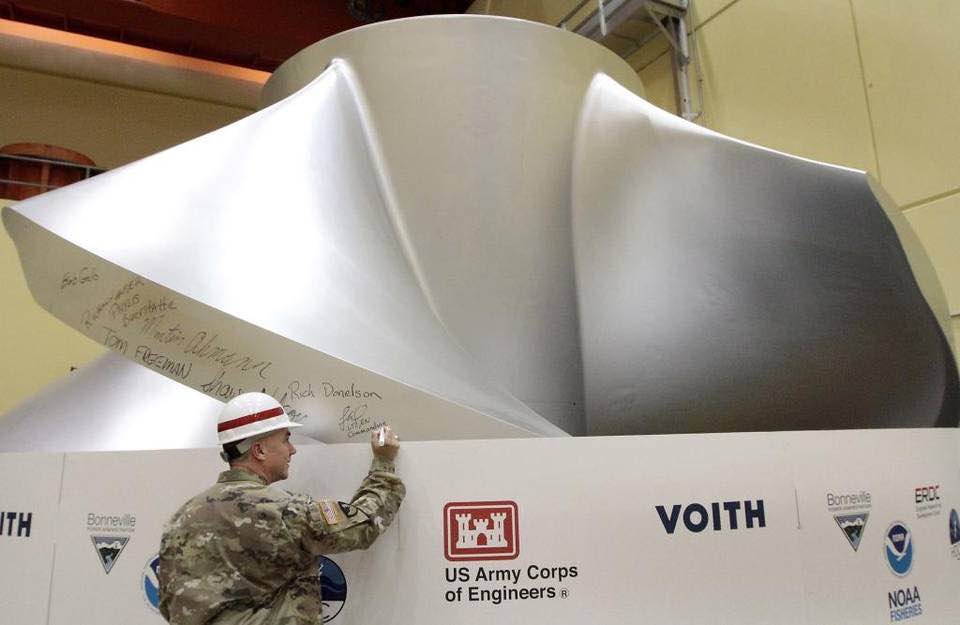forum
library
tutorial
contact

Ice Harbor Gets 150 Tons
of Fish-friendly Stainless Steel
by Annette Cary
Tri-City Herald, May 13, 2016
|
the film forum library tutorial contact |

|
Ice Harbor Gets 150 Tons
by Annette Cary
|
New turbines are state of the art for fish survival;
First one has arrived at the Snake River dam near Burbank
 The 150 tons of swirled stainless steel assembled at Ice Harbor Dam near Burbank is a "beautiful blend of engineering and art," said Kevin Crum, project manager for the Army Corps of Engineers.
The 150 tons of swirled stainless steel assembled at Ice Harbor Dam near Burbank is a "beautiful blend of engineering and art," said Kevin Crum, project manager for the Army Corps of Engineers.
Sitting on the floor of the dam's powerhouse is a high-tech, five-blade turbine designed to allow fish to glide through with less harm than through existing turbines at the Corps' dam on the Snake River.
If it works as well as hoped, it could serve as a model for other turbines at the Corps' Snake and Columbia river dams as they are replaced.
Three of Ice Harbor's six turbines date to 1961.
Rather than replace them with newer turbines for efficient hydropower generation, the decision was made to use the replacement project as a test for reducing harm to juvenile fish.
"The project flipped our design criteria," said Steve Miles, director of the Corps Hydroelectric Design Center.
Most fish pass over the dam's spillway, go through a spillway weir or go around the dam via a bypass. The remaining 5 percent come downstream through the turbine and can become disoriented or injured. Some don't make it out alive.
They face two dangers: slamming into the steel blades or dramatic changes in pressure.
The new turbine is designed to provide more uniform water flow and pressure through the turbine.
Salmon and steelhead are less likely to bang into a turbine blade.
There also is less stress on a balloon-like organ, the swim bladder, which helps a fish maintain buoyancy. A sudden shift in pressure can make it inflate suddenly, causing internal injuries.
The new turbine was a joint design project of biologists and engineers, with collaboration among Voith Hydro Inc., the Corps, the Bonneville Power Administration and NOAA Fisheries.
They spent three years making hundreds of design changes, testing models and then making more design changes. Fabricating the turbine, which stands 12 feet high and is a little more than 23 feet in diameter, took another two years.
BPA is paying for the first phase of the $58 million project, which will cover the cost of replacing the first two turbines plus fish passage improvements at Ice Harbor over the next few years. Contracts include options for the third turbine.
The first new turbine has a fixed-blade design, which offers the most opportunities for a fish-friendly blade shape. The second and planned third turbine will have adjustable blade designs that will provide flexibility to maximize the water through the turbine.
Efficiency in hydropower generation has not been ignored.
Tests with models of the new fixed-blade turbine show that it may increase power generation by 3 percent to 4 percent.
When all three of the turbines are installed, the increase in power generation should be enough to supply electricity to about 3,000 homes, said Mark Gendron, senior vice president of power services for the Bonneville Power Administration.
The Corps' Snake River dams produce enough power for about 800,000 homes.
"The efficiency and reliability benefits to the hydroelectric system are an important bonus, stretching the value of the limited water resource," said BPA engineer George Brown.
The stainless steel blades of the new turbines are expected to better resist pitting and corrosion than the original steel turbines, lasting longer and requiring less maintenance.
Installing the first blade is expected to take up to 14 months. It should be operating in 2017, and the second high-tech turbine should replace another of the dam's aging turbines in 2018.
learn more on topics covered in the film
see the video
read the script
learn the songs
discussion forum
